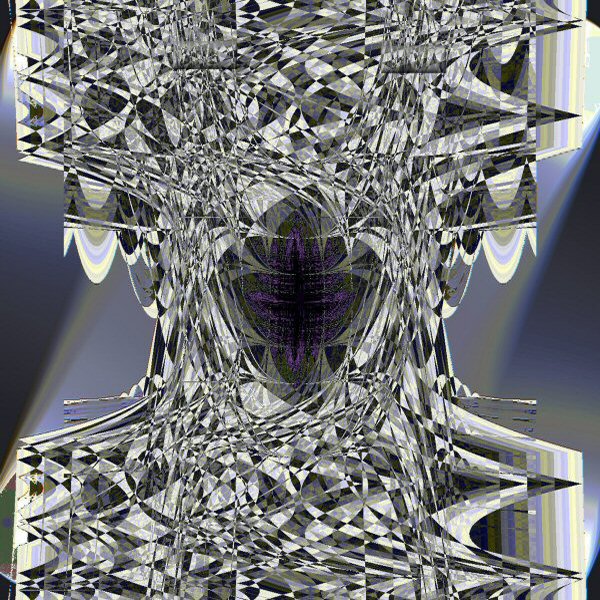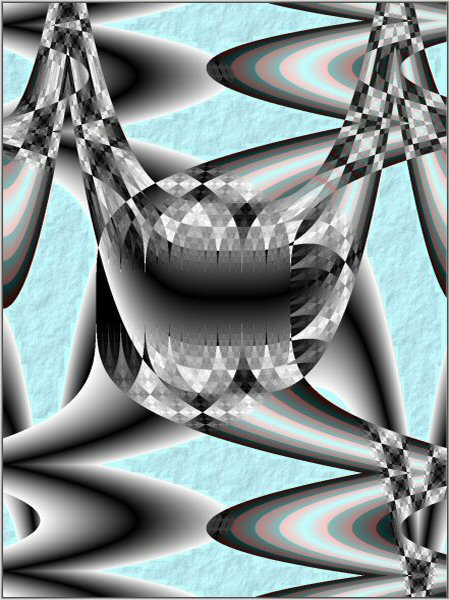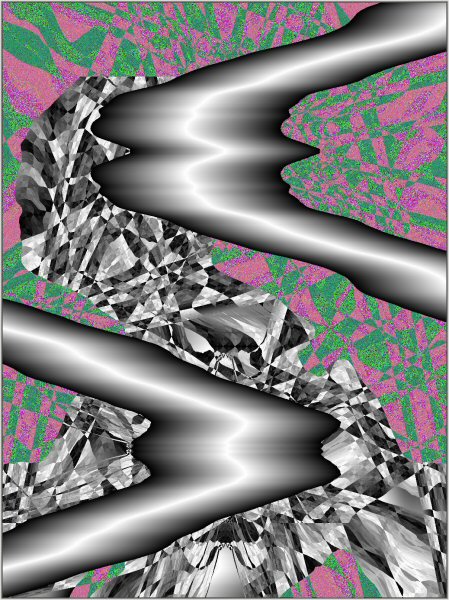Alan Sutcliffe
"Screaming Warbot"
Digital print, 18" X 18", 2006.

The program in Visual Basic uses a simple
algorithm to draw curves starting from third order differences having
small random increments. These lines are then extended laterally by
shading from black to white to give the appearance of a smoothly curved
surface. In this graphic, however, all the drawing is done in XOR mode
so that each new curve and its shading makes complex intersections with
earlier ones. The result was a surprise, which I like.
"Far Horizon"
Digital print, 19" X 7", 2006.

This graphic used the same output as
for Screaming Warbot, but with the halves rotated and placed side by
side, an edge filter was applied and the number of greyscale levels
reduced to increase clarity.
"Limbs Galore"
Digital print, 12" X 12", 2007.

This graphic was produced by a
different run of the same program as Screaming Warbot, but XOR mode for
only some of the limbs (as I think of them) and normal mode for others,
allowing the smooth surface to be seen. Texture was added to the background.
"Ying Yang with Profile"
Digital print, 12" X 16", 2007.

For this work the algorithm was
changed, substituting an equivalent formula for the method of generating
curves from differences. A scaling factor was changed to give curves
that are less smooth. The last two curves were drawn in normal mode to
lie on top of the shapes formed by using XOR for the earlier ones. The
appearance of something like a human profile in the background was
adventitious, arising from the unpremeditated approach.
"XOR: 9 Levels of Self-similarity"
Digital print, 12" X 12", 2007.

This work is premeditated and overtly
mathematical. The binary XOR operation can be applied to pairs of
integers, acting independently on corresponding bits in the binary
expression of the integers. A table was computed of i XOR j for 0 <= i, j
<= 255. From this the extended truth tables for XOR acting on integers
having to 2 ^ n bits for 1 <= n <= 9 can be made. For the graphic these
are shown as grey levels. The self-similarity in the tables can be seen,
even though we cannot distinguish 256 levels of grey.
Alan Sutcliffe
Maker and programmer, Computer Arts Society
4 Binfield Road
Wokingham
Berkshire
RG40 1SL UK
For more information about the making of these five graphics and about the XOR function see my conference
paper "A Simple Procedure to Generate Curves and Surfaces"
"Mainly I work by devising algorithms
for composing graphics, with only a general idea of what the outcome
will be. My works are intended to be evocative but not expressive,
except in the sense that everything we do is expressive. The titles I
give works are best ignored.
Increasingly I look for seemingly simple sets of rules that have complex
and unpredictable outcomes. I prefer to do little or no processing of
the output from a program and only for simple actions such adding
texture to an area or putting a border round a picture. My approach is
based on a sense of what will work rather than an attempt to model
so-called creative processes. I compose music in a similar way.
Sometimes I make premeditated works in the conventional way, and these
may not involve programming nor have a mathematical connection."